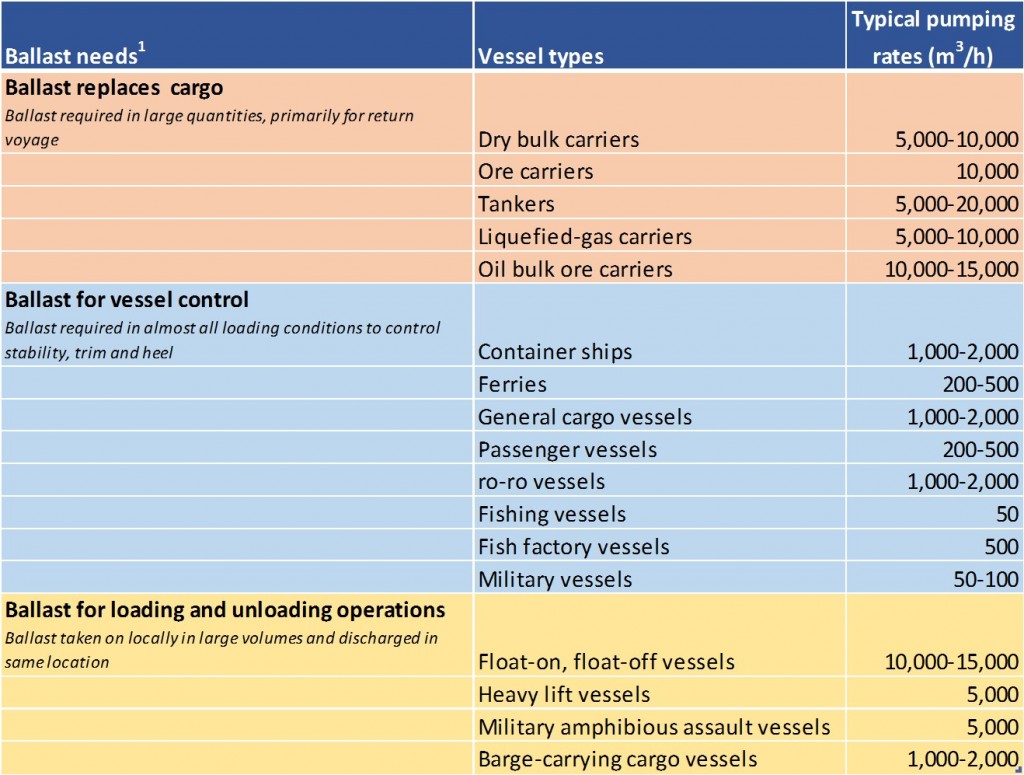Shipping is essential to the global economy, providing the most cost-effective means of transporting bulk goods over great distances. Over 90% of all global trade – including everything from food and fuel to construction materials, chemicals and household items – is carried by ships, with some 50,000 merchant ships sailing the world’s oceans, with a combined tonnage of around 600 million gross tonnes.
Ships are specifically designed and built to move safely through the water while carrying this cargo. But, when the ship is travelling either without cargo, or only partially laden, it must take additional weight on board to enable it to operate effectively and safely by, for example, keeping the ship deep enough in the water to ensure efficient propeller and rudder operation. This additional material is called ballast.
The IMO Ballast Water Management Convention defines ballast water as water with its suspended matter taken on board a ship to control trim, list, draught, stability or stresses of the ship.
When ships were first built years ago, they carried solid ballast, in the form of rocks, sand or metal. However, since around 1880, ships have used water as ballast principally because it is more readily available, much easier to load on and off a ship, and therefore more efficient and economical than solid ballast. When a ship is empty of cargo, it fills with ballast water. When it loads cargo, the ballast water is discharged.
It is estimated that some 3-5 billion tonnes of ballast water is transferred throughout the world each year with an individual ship carrying anything from several hundred litres to more than 130,000 tonnes of ballast water, depending on the size and purpose of the ship. A potentially serious environmental problem arises when this ballast water contains marine life.
Since just one cubic metre of ballast water may contain up to 50,000 zooplankton specimens (Locke et al.1991, 1993; Gollasch 1996; Kabler 1996) and/or 10 million phytoplankton cells (Subba Rao et al. 1994), and the majority of marine species include a planktonic phase in their life cycle, there are literally thousands of different marine species that may be carried in ships’ ballast water – basically anything that is small enough to pass through a ships’ ballast water intake ports and pumps. This includes bacteria and other microbes, small invertebrates and the eggs, cysts and larvae of various species, including most fish, although not all of these will survive in the ballast tank because it is a hostile environment with considerable disturbance, lack of food and light.
Closely associated with ballast water are ballast sediments. When a ship takes on ballast water it also takes on material contained in the water. In turbid or shallow waters this often includes solid material. When this material enters the ballast tank it settles to the bottom as ‘sediment’ and provides a substrate for a variety of marine species, notably dinoflagellates. According to the Convention sediments are defined as “Matter settled out of ballast water within a ship”.
Ballast water is thus recognised as one of the principal vectors of potentially invasive alien species, and is estimated to be responsible for the transfer of between 7,000 and 10,000 different species of marine microbes, plants and animals globally each day (Carlton, 1999).
Ballast water requirements on board ships
Ballast water is taken on board using sea chests with ballast pumps or by gravity feed. Sea chests can be located under the ship, on the turn of the bilge, or on the ship’s side and are usually replicated on both sides of the ship. The ballast system usually works in reverse during deballasting, with the water passing through an overboard discharge valve located on the side of the ship’s hull. Ballast water loading and discharging operations are usually controlled from a central ballast monitoring/control station and ballast water can be gravitated in or out of a particular tank or hold, pumped in or out, or a combination of these methods can be used. Ballast pumps remove most of the ballast water.
Ballast is taken onboard a ship for the following purposes:
- to maintain stability of the ship;
- to keep the hull stresses of the ship within permissible limits;
- for operational reasons such as reducing air-draft, adjusting trim, correcting list or producing list for stripping of tanks etc.
Ballast tank arrangements on board different types of ships are to meet the requirement of ballast water on board. Structural arrangements and ballast capacities on different classes of ships are given below:

Ballast water capacities for different types of ships
Typical ship types, ballast water needs and pumping rates
1 – The three categories of ballast needs are not mutually exclusive. For example, a vessel in which ballast replaces cargo may also require ballast to control stability.





